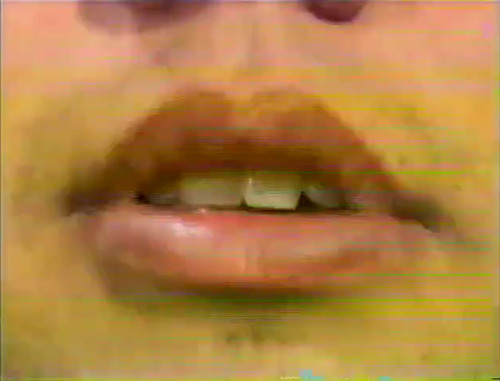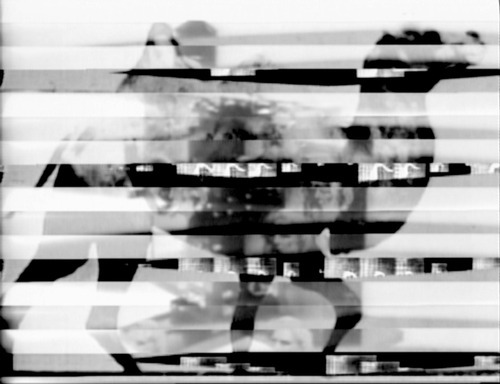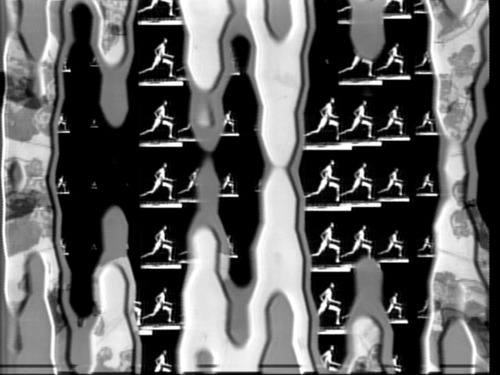Tell us about your approach to visual art. How it all started?
Eric Souther (ES): It is important to my work that the initial images are performative, i.e. created in real time. It allows me to have a dialogue with what I am creating in the moment. This way of working connects back to early video art, specifically signal processing. I started understanding this process during my undergraduate studies at Kansas City Art Institute as a sophomore exploring MAX/MSP & Jitter, software to make software. A colleague and I started making interactive installations and exploring the possibilities of real-time audio-visual manipulation. Around the same time I was looking at the works of Nam June Paik, Woody & Steina Vasulka, and Gary Hill.
How did your research evolve with respect to those early days?
ES: I became less interested in interactivity. I lost too much control over the message to a “fun house” effect. I still build custom software for each of my pieces that allow me to process and manipulate video in real-time, but the performative nature is in the creation of the recorded images. There has always been a fascination of two things that tied a lot of my early research together complexity and the unseen. Eadweard Muybridge and Jules Marey’s photographs inspired my obsession with the unseen. Their photographs enabled us to see the unseen layers of time by means of a technological tool. I think I’ve always pushed for the creation of software that could do the same. My interest in complexity began when I read the Tibetan Book of the Dead, and came across the notion of 10,000 things. I wanted to contextualize the 10,0000. The evolution of my research began here and I became progressively more interested in the exploration of the ritualistic spaces of the media. How do we exist within this digitally saturated world? How can ritual help us understand the complexities of that existence?

© Eric Souther, ‘Ritual for the Death of a Tree’, 4-Channel Video, 2013
Tell us about your educational path. What about your studies at M.F.A in Electronic Integrated Arts from Alfred University?
ES: The Electronic Integrated Arts M.F.A. program at Alfred University is a fantastic program with outstanding faculty. The program is very focused on self-directed artistic exploration and production. The two-year program main component consists of faculty advisors visiting your studio once a week for an hour to discuss current projects and their progression. It was a life changing experience to be able to work on my own work every day, all day and night for two years. I can’t give enough thanks or praise to the EIA program.
Any course or professor that influenced you or that you still remember?
ES: Of course, it is hard to name only one, however the chair of my M.F.A thesis committee, Andrew Deutsch, was significant to the progression of my work. Deutsch has a way of getting to the heart of the matter in critiques. He pushed me to rethink many elements of my work.
The one class that forever changed my work, and inspired many pieces since, was “Myth, Ritual and the Creative Process” taught by Professor Tom Peterson. I believe he had been teaching this same course for over fifteen years. It was brilliantly laid out with each text/religion we studied building onto the next.

© Eric Souther, still image 'Repetition and Its Discontents’, Single Channel Video, 2012
You are now Assistant Professor of New Media at IU South Bend. Tell us about this experience?
ES: It is essential for me to be immersed in a creative community. I enjoy watching how my students solve problems creatively and seeing their work grow over the years. I am happy I get to teach courses that directly relate to my expertise and creative practice. I teach Video Art, The Artist and New Media, Video Production Workshops, Interactive Multimedia, and Intro to Computer Programming. I host open screenings twice a semester and also produce a 30 minute public broadcast of student video work called “Arts Codec.” The biggest thing I’ve worked on is a new concentration in Video and Motion Media, with four new additional video courses. It has been in the works for three years now and we finally get to offer it in the Fall 2015 semester.
Eadweard James Muybridge was an English photographer important for his pioneering work in photographic studies of motion, and early work in motion-picture projection. Your work 'Dissecting Muybridge' recontextualizes that experience. What do you think you’ve figured out through this research?
ES: An inherent critique of the moving image itself arises out of the recontextulization of Muybridge’s work. The three parts of the series attempts to explore the visual metaphors and aesthetic histories of each medium or genera of film, analog video, and digital video. Part one begins with a succession of sequential images creating movement and progresses into notions of films strips, disintegration, and manipulation of the material itself. I relate this to the structural film movement and flicker films that use direct painting or exposing directly on the film, (like the works of Paul Sharits and Stan Brakhage, respectively). Part two has inherent qualities known only to analog video, which focuses on the live manipulation of the signal and its abilities to not only move up and down like the filmstrip, but left and right as well. Finally, in part three we have visuals that only could be generated via the computer, with mass duplication of the video frame.

© Eric Souther, still images 'Dissecting Muybridge’, 2014
What has stuck with me the most from the process of creating this series is the need to push the length of production. To give myself time to explore and find different ways of seeing by constantly finding new ways of manipulating and generating images. In the past, I would find a process that worked and make an entire piece out of it. This work contains many processes, which gives the work depth.
As you wrote “Screens are how we interface with the digital, with others, and with ourselves”. It’s perfect said. Sometimes when I think of this concept it seems to me that we are at the beginning of something so big that I can hardly guess where are the borders. Where are we going? And what it costs us to keep pace with technological progress?
ES: I’m not sure we know where we are going, because we are surrounded and in the middle of it, but I think most of us like it that way, or at least we don’t seem to mind. I always think back to the way Marshall McLuhan used Edgar Allan Poe’s “A Decent into the Maelstrom” to illustrate how technologies pull down into the vortex. McLuhan used this story as a wise tale, essentially stating that if we can study the vortex we can develop methods of evading it; but I think we enjoy life in the vortex, we enjoy the constant update. The repercussions are only visible through the rear view mirror and we don’t look back very often.
What “digital vs analog” does mean for you?
ES: My relationship with these two changed dramatically after my residency at Signal Culture in February 2014; I created the “Dissecting Muybridge,” parts I and II during my time there. For many years now I have been developing interactive real-time systems to create my work, which I thought was very free and exploratory, however not compared to analog. Analog is a very immediate way to experiment with video and audio. It is quite different to twist knobs, push buttons and make physical patches (i.e. connections of video signals via cables to different areas of the system) than it is to code and construct software. The latter is a completely different mindset than analog. The immediacy of analog creates a feedback loop between the artist and the visual.
Signal Culture has built an amazing studio; a seamless digital to analog and back to digital system with modular components. The analog equipment is fairly rare, most was built in the 70s. My stay there has completely changed my practice. I purchased an analog synthesizer that has digital to analog control voltage and also control voltage to MIDI back to the computer, which with some work can allow me to create performative analog/digital systems. The first project I developed with this system is “Multiplying Muybridge”, an audio-visual performance, which is new to mode of presenting my work.

© Eric Souther, still images ‘Dissecting Muybridge’, 2014
Today we are immersed in an ocean of images. Your work 'Search Engine Vision: Christ’ is a good representation of this feeling of media iteration, iconic redundancy and erosion of meaning. What causes this thought in your mind?
ES: Originally this idea was inspired by Joseph Kosuth piece “One and Three Chairs,” where he has a chair, a picture of a chair, and the definition of a chair side by side. I was curious how we would define objects via the masses. If we could find 1,000 user-tagged chair videos or images via a search engine, would we still be able to understand the results as chair? This resulted in a piece titled Search Engine Vision “Chair”, and later led to SEV “Buddha” and SEV “Christ”.
The role of art is to escape from the media vicious circle and their overdose, or is to trigger short circuits from inside?
ES: I think the role of art is to allow one to see different perspectives, which leads to new ways of seeing and thinking. I would say, though, that my work does break, hack, and subvert the language of media in order to, as you say, create short circuits from the inside.
Is there any contemporary video or not video artist that influenced you or that you like better some way?
ES: I would say Woody and Steina Vasulka, Bill Viola, Name June Paik, John Cage, Karlheinz Stockhausen, and Gary Hill.
Three books that you recommend?
ES: - Materializing New Media: Embodiment in Information Aesthetics by Anna Munster.
- Screens: Viewing Media Installation Art: 30 by Kate Mondioch.
- Conversations with Ogotemmeli: An Introduction to Dogon Religious Ideas by Marcel Griaule.
How do you deal with the exhibition of your works. Also is there any show you’ve seen recently that you find inspiring?
ES: It depends on the work. I have a lot of single channel work that is easy to send to places via WeTransfer and Dropbox, and flat screens and projectors are fairly affordable and easy to come by. For some of my installation works I travel to location to install. It’s a challenge to create an autonomous system that is seamless for the gallery or museum that is exhibiting the work. I did get to see the Takashi Murakami “In the Land of the Dead, Stepping on the Tail of a Rainbow” exhibition at the Gagosian Gallery in Chelsea in January. The scale was impressive and immersive. I enjoyed the integration of eastern religious icons and contemporary re-amalgamations.


© Eric Souther, 'Projecting Buddha’, Multimedia Installation, 2013
Projects that you are working on now and plans for the future?
ES: At the moment I’m collaborating with some musicians to develop a live audio responsive performance for a program called Art Sounds at the Kansas City Art Institute March 10th. The piece is about an artificial intelligence that is attempting to learn the audio-visual language of its creators. Part one is the programming, part two is the computer trying and failing with ample datamoshing, and part three the AI and live performers are improvising together. I am also working on a new series called Masks of the Media. I was inspired by the idea of mono myth, and applying it to archetypes of cinema and television as a type of possession and assimilation. I am still working on the logistics of either projection mapping onto an actual mask or having a virtual one that maps to the viewer’s face. They would be similar to the Search Engine Vision pieces in that they will have a mass collection of videos playing all at once and at random picking videos to go full screen.
Who would you suggest to interview for an upcoming interview that you would like to read?
ES: I would suggest Jason Bernagozzi and Michael Lasater.
---
LINKS
Eric Souther
United States
share this page